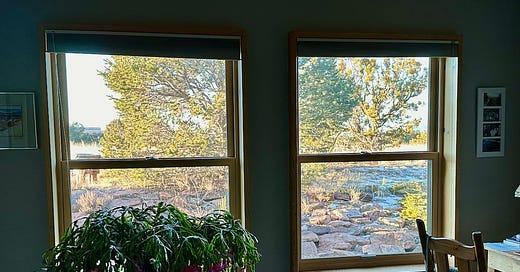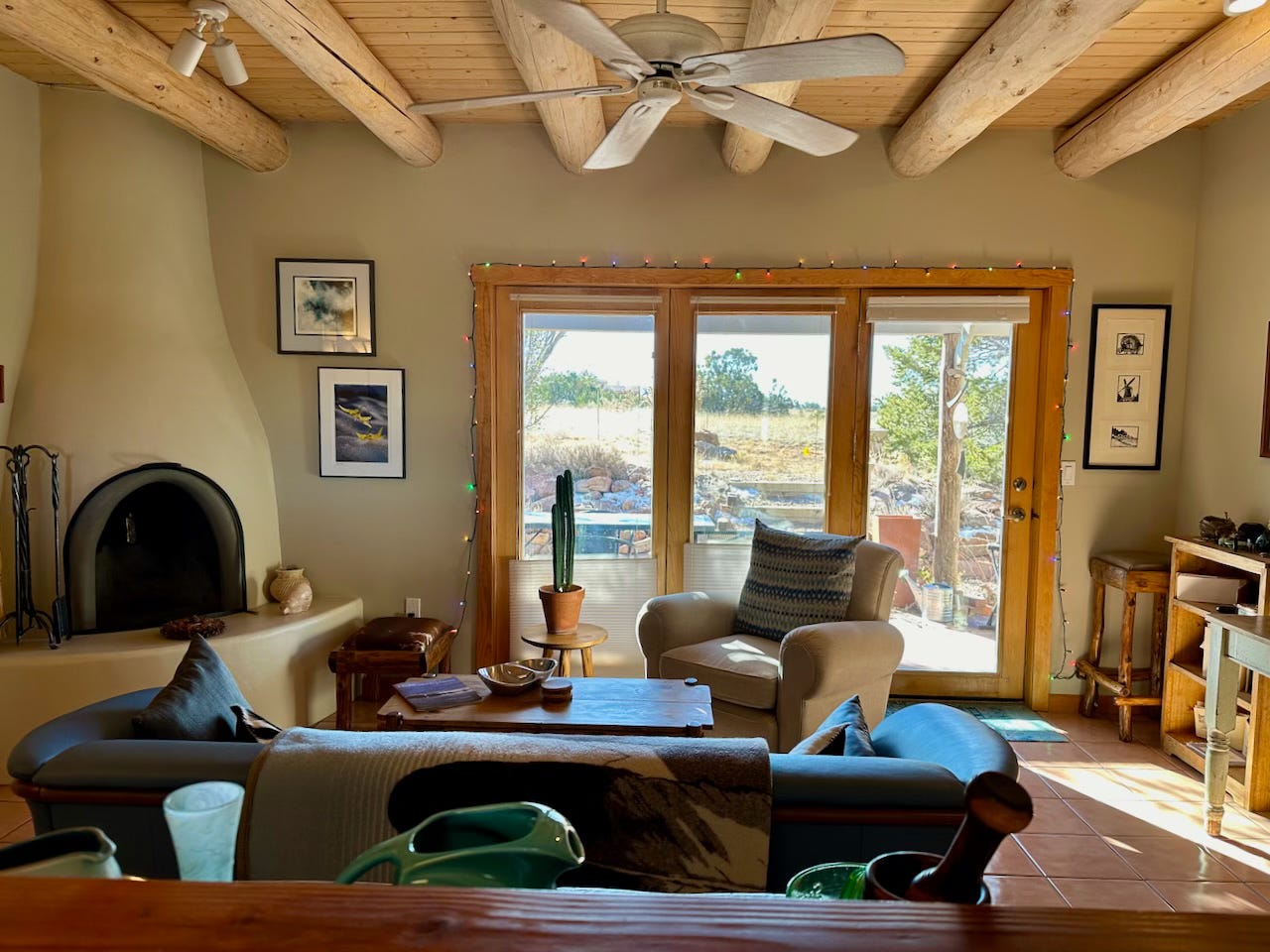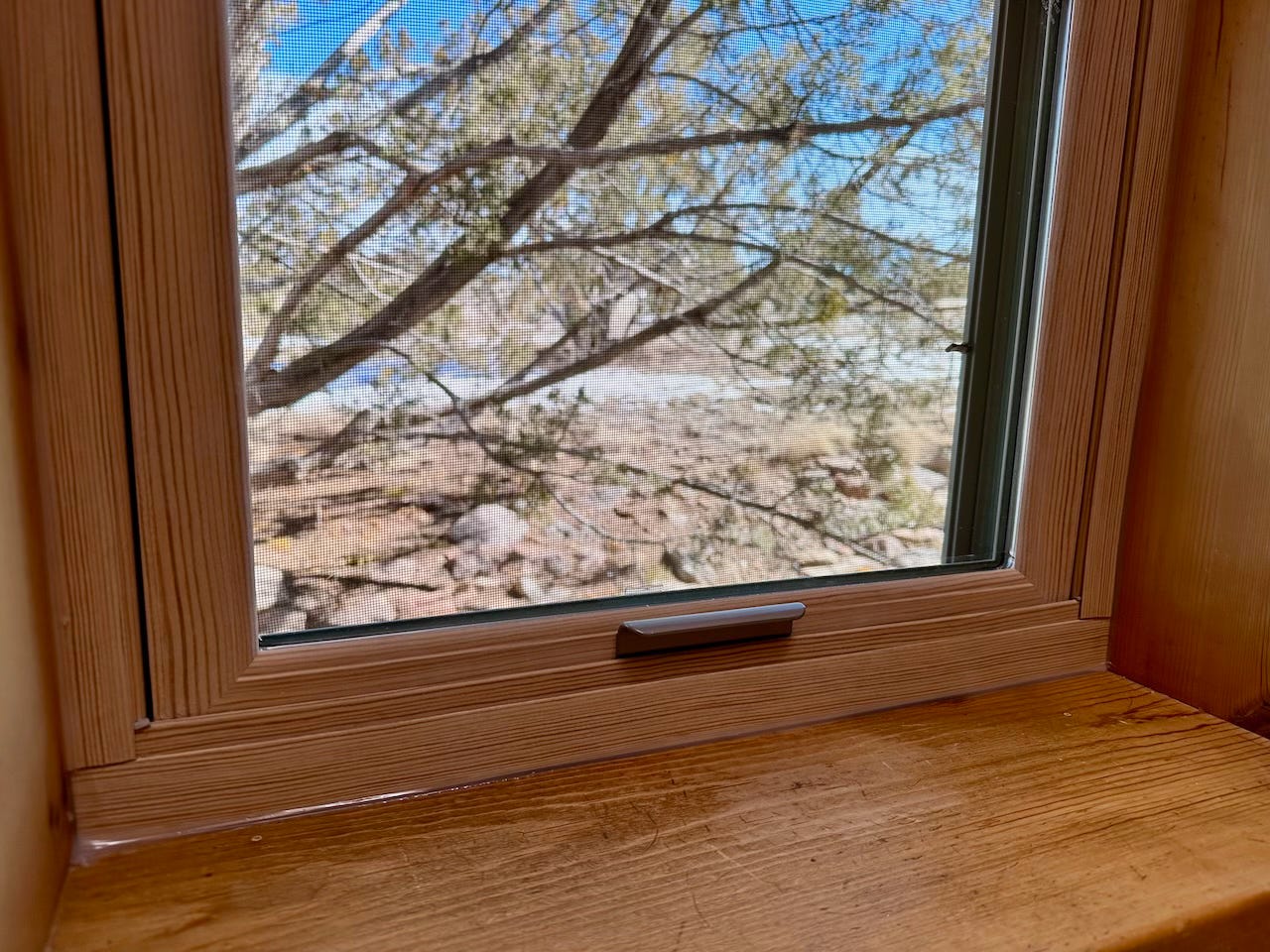blinds open wide these two windows welcome sunlight food for leaf and spirit
I write next to Arabella and these two beautiful windows, with their warm south light in winter. They are my eyes on the world: I watch bluebirds, juncos and robins in the piñon pine and juniper trees, see the moonlight silver frosty grasses and snowflakes blowing past, hear coyotes sing and revel in sunsets flaming the sky.
Hello Friends! It’s Tuesday and time to practice gratitude to lift our spirits and give us some brightness in difficult times. Today I am grateful for something entirely prosaic and also entirely awesome: windows.
A bit on windows: they’re a relatively modern invention. The earliest human domiciles, whether seasonal brush houses or caves in solid rock, packable structures made of tanned skins or earth-sheltered structures, had openings to admit light and air, but nothing to cover those openings, so they were usually small to keep heat in and weather out. (The word window comes from an Old Norse word meaning “wind” and “eye,” which gives you an idea of how drafty those small openings were!)
The earliest window materials were translucent rather than clear, including parchment or rice paper, sometimes oiled; flattened pieces of animal horn and sheets of mica. They might have screens, lattices of wood or stone, but they didn’t have glass panes until the 1400s, and glass windows weren’t widely used until several hundred years later. The technology for making large sheets of glass for the floor-to-ceiling windows we know today wasn’t invented until the 1930s.
Glass itself was invented about 2,000 years ago, when some Roman smithy near Alexandria in Egypt heated quartz sand on her forge to over 3,000 degrees F (which, incidentally is the temperature that the space shuttle skin heats on re-entering Earth’s atmosphere). At that temperature, the silicon crystals in sand melt, and reform as an amorphous solid, a sturdy state between a solid and a liquid. That material is glass.
Making glass stable and long-lasting is trickier than just melting sand, and involves adding limestone or other minerals to keep the amorphous solid, well, solid. Modern glass is heated and cooled repeatedly to “temper” it and make it less likely to shatter.
Why I think about windows
Perhaps you’ve never thought about your windows. After completing nine house “re-storying” projects—Casa Contenta is my tenth and last—and being very concerned with preserving the look and feel of a house while leaving it much more energy efficient for a lighter footprint on the planet, windows are high on my list of concerns.
When I bought Casa Contenta, I knew the house had not had any major maintenance in at least a decade or perhaps two. Like people, houses age, and like us, they need care and tending as they get older.
Casa Contenta is a passive-solar design: it has large, south-facing windows that let in abundant solar energy during the cold months to warm the house. (Overhangs shade those windows in the hot months when the sun is high overhead.)
It’s a lovely design, but it depends on tight, well-insulated windows. Which the original windows were not. They were 30-year-old double-paned windows framed with uninsulated metal. Some of the seals between the panes had leaked and lost the insulating layer of air in-between.
Here’s what I mean by leaking heat: On the first really cold morning, when the overnight low was 10 degrees F, I opened the blinds to find frost on the inside of the windows. Meaning the air temperature between the blinds and the window panes was below freezing. I touched one metal frame and my finger burned. Brr.
So I considered my budget and decided I could squeeze out enough cash to replace the worst of the leaking windows, eight in total. When the bid came in for the replacement windows plus defenestration (a fancy word for removing the old windows) and installation of the new, I gulped at the amount, and then said yes.
It took about two months for the custom-made windows to arrive. Finally, last week, the guys came and spent one very windy January day removing the old windows—the house got a good airing out in the doing!—and putting in the new ones, which have composite wood sashes with a fiberglass cladding on the outside. Very material-efficient and energy-efficient.
Immediately I noticed the house was quieter, as if sound-dampened. And cozier, with none of the drafts I could feel creeping across the floor near the old windows. And the new windows are beautiful too, their composite wood complimenting the thick ponderosa pine window trim and deep sills.
Hence my gratitude for windows this morning, as I sit in my quiet, toasty house with the winter sun streaming in through my new windows.
What prosaic but marvelous things are you grateful for today? Hit the comment button below and share!
Resources
Window history plus etymology: https://en.wikipedia.org/wiki/Window
How glass is made: https://www.corning.com/worldwide/en/innovation/materials-science/glass/how-glass-made.html







I'll have to say that good windows and natural light are right at the top of my list. Although this old house (1918) isn't well situated for solar gain, plenty of windows make the sunlight and moonlight wonderful. I replaced the majority of them, and added one in the bathroom. They are not the highest quality, but my comfort level shot up, not to mention my mood when I could finally watch deer, antelope, birds, the occasional elk and coyote, the changing light over the hills and ridges, and the ever changing Wyoming cloudscapes. Grateful every day...
Windows let in light. Without much snow before the new year, I found myself turning on the lights during the day when I can usually see fine indoors during daylight hours. Now we've got good ground cover and the days are brighter; and longer. But I have to ask about those gorgeous windows. Are they Marvin Windows? I ask because their headquarters is in Warroad, Minnesota, a special place I've been writing about. Their company history is quite remarkable and their custom windows are stunning.